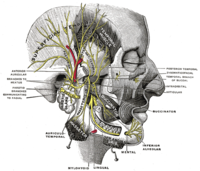
Photo from wikipedia
Botulinum Toxin injections into salivary glands (SG) up to a total dose of 100 units IncobotulinumtoxinA (IncoA) represent the treatment of choice for sialorrhea. However, BTX might also protect SG… Click to show full abstract
Botulinum Toxin injections into salivary glands (SG) up to a total dose of 100 units IncobotulinumtoxinA (IncoA) represent the treatment of choice for sialorrhea. However, BTX might also protect SG against sialotoxic radioligand cancer therapies. The radioligand Actinium-225-PSMA effectively targets Prostate Cancer (PCa) metastases but inevitably destroys SG due to unintended gland uptake. A preliminary case series with regular-dose IncoA failed to reduce SG PSMA-radioligand uptake. We therefore increased IncoA dosage in combination with transdermal scopolamine until a clinically relevant SG PSMA-radioligand uptake reduction was achieved. Ten consecutive men with metastasized PCa refractory to all other cancer therapies received gradually increasing IncoA dosages as part of a compassionate use PSMA-radioligand-therapy trial. The parotid gland received six and the submandibular gland three injection points under ultrasound control, up to a maximum of 30 units IncoA per injection point. A maximum total dose of 250 units IncoA was applied with up to 170 units per parotid and 80 units per submandibular gland. Treatment was well tolerated and all side-effects were non-serious. The most frequent side-effect was dry mouth of mild severity. No dysphagia, facial weakness, chewing difficulties or systemic side-effects were observed. SG injections with IncoA up to a total dose of 250 units are safe when distributed among several injection-points under ultrasound control by an experienced physician. These preliminary findings lay the basis for future trials including BTX as major component for SG protection in established as well as newly emerging radioligand cancer therapies.
Journal Title: Toxins
Year Published: 2022
Link to full text (if available)
Share on Social Media: Sign Up to like & get
recommendations!